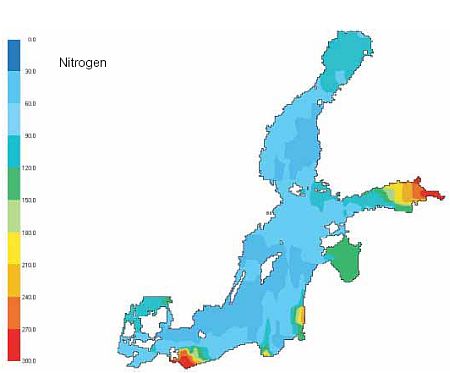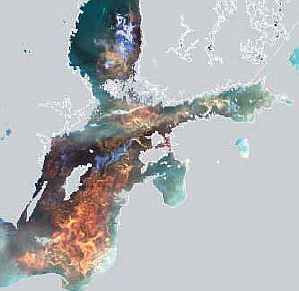Nutrient concentrations in the Baltic remain high Regional distribution of nitrate nitrogen (µg/l) in the surface water, January–February 2000 (Source: SYKE).
Regional distribution of nitrate nitrogen (µg/l) in the surface water, January–February 2000 (Source: SYKE).

High nitrate concentrations are still prevalent in the Bothnian Bay, the Gulf of Finland, the Gulf of Riga, the Pomeranian Bay, the Belt Sea and the Kattegat. Concentrations of both nitrogen and phosphorus have increased in deep waters.
In general, nutrient concentrations in the Baltic Sea have not decreased since the assessment period 1994–1998, and remain persistently high. But from a longer-term perspective different trends can be seen. Since 1980, winter surface concentrations of dissolved inorganic nitrogen compounds (nitrate + nitrite) have decreased significantly in the northern Baltic Proper.
Internal load due to oxygen deficiency
Low oxygen concentrations in deep water affect the amounts of nutrients in the water. Phosphorus is easily released from sediments under anoxic conditions, for instance. Nitrogen cycles in deep water layers also change in anoxic conditions: mineralization eventually produces ammonium, and no oxidation occurs to form nitrates. Consequently, the process of denitrification, i.e. turning nitrates to gaseous nitrogen, will not occur. The resulting nutrient surplus in deep water layers is a potential source of nutrients for the surface layers, where primary production may be further increased.
Phytoplankton blooms

Planktonic algae are an important part of marine ecosystems, and algal blooms at sea are naturally occurring phenomena. However, these mass occurrences of microscopic algae have become more frequent and intense due to the eutrophication of the sea, which is caused by various types of human activity. Harmful and toxic algal blooms have occurred annually in the Baltic Sea in recent years. Extensive and dense blooms disrupt marine ecosystems, and limit the recreational and economic use of marine resources. Algal blooms can also be toxic, and thus represent a real health risk for humans and animals, as well as an aesthetic problem. Further information on algal blooms is available in the HELCOM Indicator Fact Sheets.
For more information about phytoplankton, see:
Biovolumes and Size-Classes of Phytoplankton in the Baltic Sea
See HELCOM Publications

